Proposal for Enhancing Quality Development in Healthcare Settings
VerifiedAdded on 2020/03/04
|18
|4143
|58
Report
AI Summary
This report presents a proposal for quality development in a healthcare setting, focusing on reducing medication errors and improving patient safety. The author identifies at-risk behaviors among healthcare professionals as a primary cause of errors, leading to compromised patient care. The proposal outlines five key interventions: establishing a governing body to improve the work environment, allocating senior nurses for monitoring and skill development, promoting teamwork, implementing regular training classes, and fostering a culture of safety. The report details the methods for each intervention, including the composition of teams and the roles of various personnel. A monitoring body will assess the impact of the interventions through observational studies, complaint analysis, skill assessments, nurse interviews, and patient feedback. The aim is to create a safer, more efficient healthcare environment by addressing the root causes of medication errors and promoting continuous improvement.
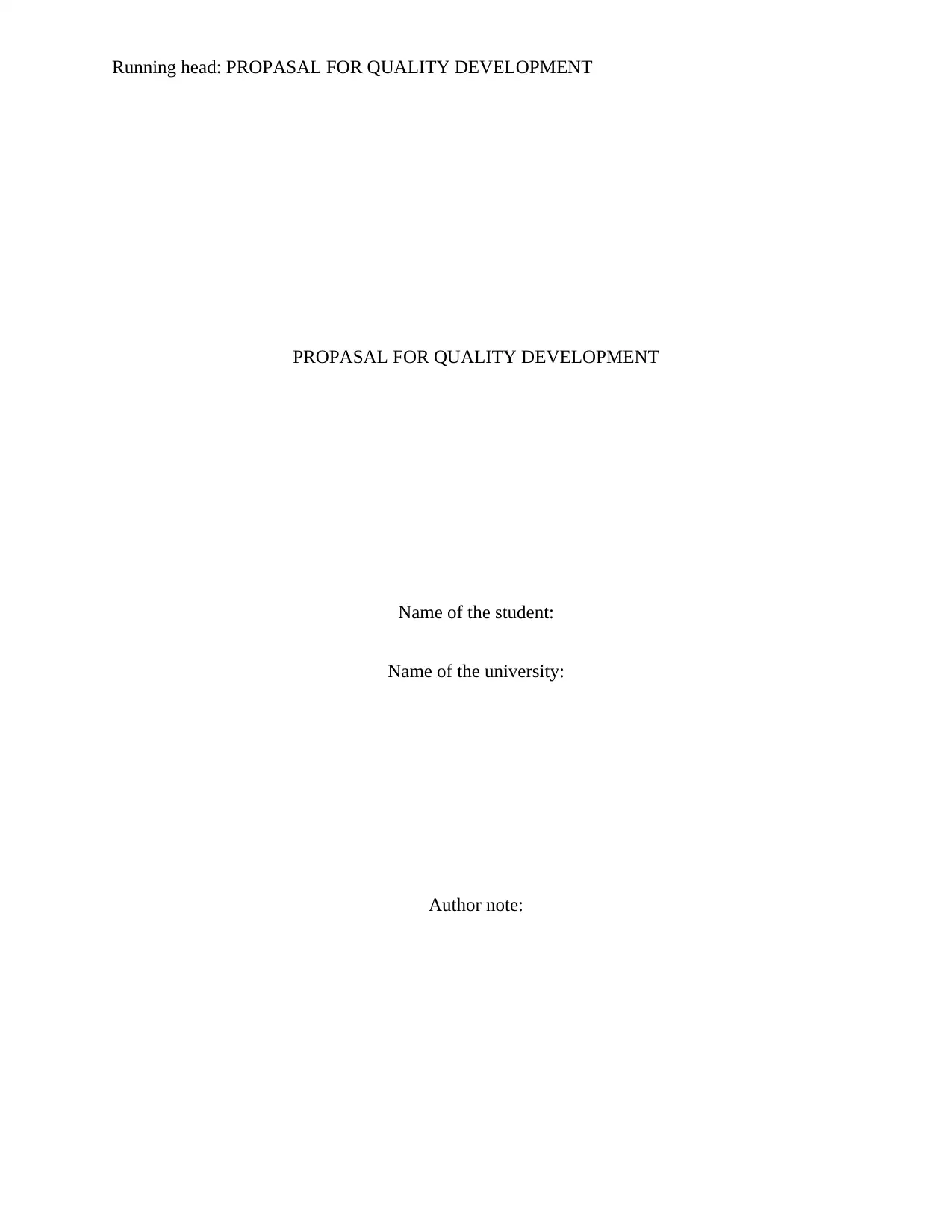
Running head: PROPASAL FOR QUALITY DEVELOPMENT
PROPASAL FOR QUALITY DEVELOPMENT
Name of the student:
Name of the university:
Author note:
PROPASAL FOR QUALITY DEVELOPMENT
Name of the student:
Name of the university:
Author note:
Paraphrase This Document
Need a fresh take? Get an instant paraphrase of this document with our AI Paraphraser

Introduction:
Problem description:
It is human nature to complete any task with the shortest methods and by spending the
last time on the task. Healthcare professionals are no less and therefore these activities often lead
to many adverse as well as legal complicacies. These actions may lead to or be a result of at risk
behaviors (Carayon et al. 2014). Often at risk behaviors taken by the health care practitioners
result them in compromising the patient safety. Due to the immediate benefit they get, they fail
to look at the harm they are exposing the patients to harm and making them risk their lives
(Graban 2016). As these behaviors often result in saved time, convenience and comfort, the
perceived benefits of taking shortcuts gradually tend to make the healthcare practitioners more
exposed to making it a habit. Often the most harmful effects ha are noticed in the hospitals due to
his at risk behaviors of the professionals are medication errors (Van Bogaert et al. 2014).
Medication errors mainly take place when nurses follow improper routes of drug administration,
improper application of medicines without seeing the expiry work or without even seeing the
names properly, improper timing of the medication administration, overdose or under dose of
medications and many others (Laschinger 2014). Hence, due to all these errors caused by the
nurse either due to at risk behaviors or due to ignorance of taking their profession seriously, the
main sufferers are the patients (Tourangeau 2016). As a result the quality of care provided is
compromised and even the patients have longer hospitals stays, poor health and overflow of
resources.
Problem description:
It is human nature to complete any task with the shortest methods and by spending the
last time on the task. Healthcare professionals are no less and therefore these activities often lead
to many adverse as well as legal complicacies. These actions may lead to or be a result of at risk
behaviors (Carayon et al. 2014). Often at risk behaviors taken by the health care practitioners
result them in compromising the patient safety. Due to the immediate benefit they get, they fail
to look at the harm they are exposing the patients to harm and making them risk their lives
(Graban 2016). As these behaviors often result in saved time, convenience and comfort, the
perceived benefits of taking shortcuts gradually tend to make the healthcare practitioners more
exposed to making it a habit. Often the most harmful effects ha are noticed in the hospitals due to
his at risk behaviors of the professionals are medication errors (Van Bogaert et al. 2014).
Medication errors mainly take place when nurses follow improper routes of drug administration,
improper application of medicines without seeing the expiry work or without even seeing the
names properly, improper timing of the medication administration, overdose or under dose of
medications and many others (Laschinger 2014). Hence, due to all these errors caused by the
nurse either due to at risk behaviors or due to ignorance of taking their profession seriously, the
main sufferers are the patients (Tourangeau 2016). As a result the quality of care provided is
compromised and even the patients have longer hospitals stays, poor health and overflow of
resources.
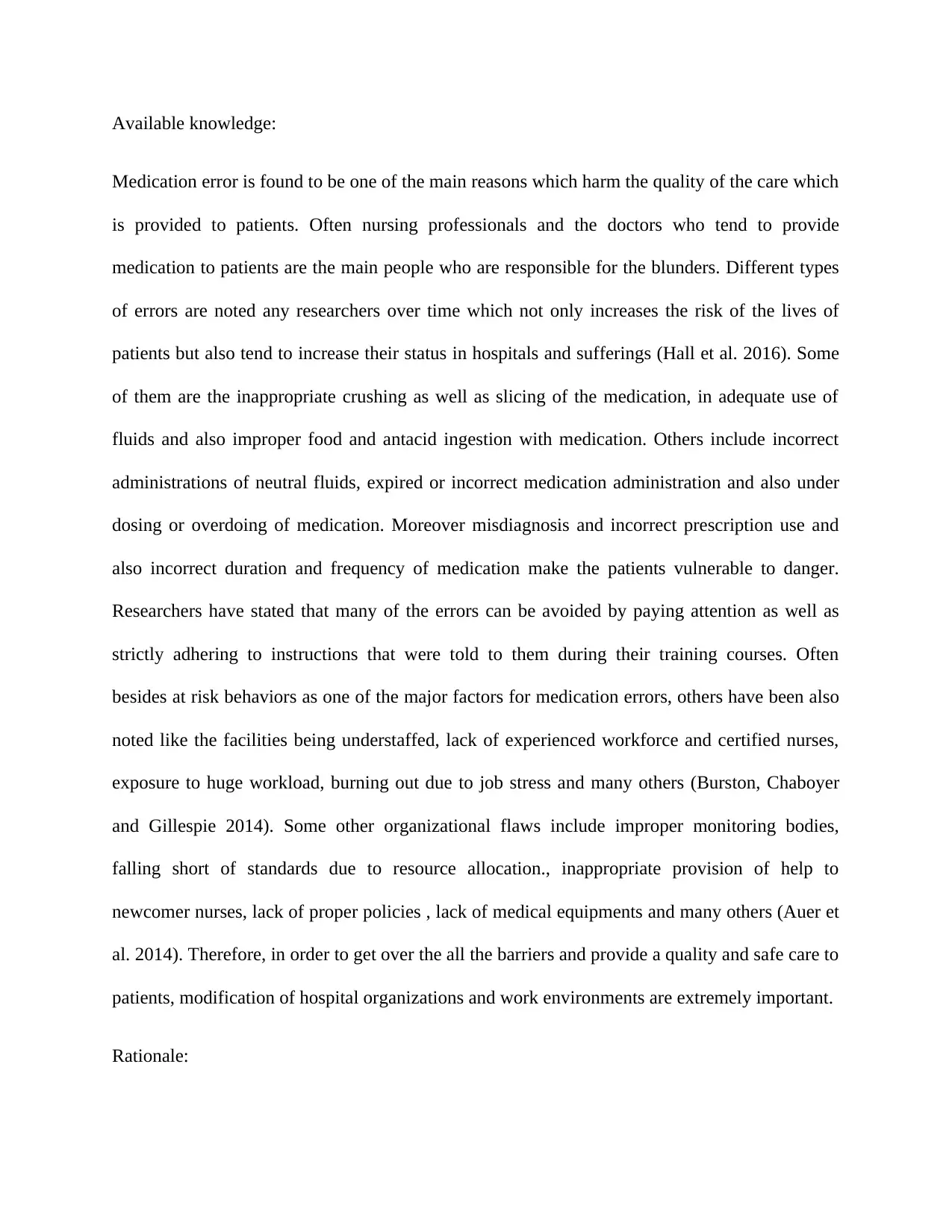
Available knowledge:
Medication error is found to be one of the main reasons which harm the quality of the care which
is provided to patients. Often nursing professionals and the doctors who tend to provide
medication to patients are the main people who are responsible for the blunders. Different types
of errors are noted any researchers over time which not only increases the risk of the lives of
patients but also tend to increase their status in hospitals and sufferings (Hall et al. 2016). Some
of them are the inappropriate crushing as well as slicing of the medication, in adequate use of
fluids and also improper food and antacid ingestion with medication. Others include incorrect
administrations of neutral fluids, expired or incorrect medication administration and also under
dosing or overdoing of medication. Moreover misdiagnosis and incorrect prescription use and
also incorrect duration and frequency of medication make the patients vulnerable to danger.
Researchers have stated that many of the errors can be avoided by paying attention as well as
strictly adhering to instructions that were told to them during their training courses. Often
besides at risk behaviors as one of the major factors for medication errors, others have been also
noted like the facilities being understaffed, lack of experienced workforce and certified nurses,
exposure to huge workload, burning out due to job stress and many others (Burston, Chaboyer
and Gillespie 2014). Some other organizational flaws include improper monitoring bodies,
falling short of standards due to resource allocation., inappropriate provision of help to
newcomer nurses, lack of proper policies , lack of medical equipments and many others (Auer et
al. 2014). Therefore, in order to get over the all the barriers and provide a quality and safe care to
patients, modification of hospital organizations and work environments are extremely important.
Rationale:
Medication error is found to be one of the main reasons which harm the quality of the care which
is provided to patients. Often nursing professionals and the doctors who tend to provide
medication to patients are the main people who are responsible for the blunders. Different types
of errors are noted any researchers over time which not only increases the risk of the lives of
patients but also tend to increase their status in hospitals and sufferings (Hall et al. 2016). Some
of them are the inappropriate crushing as well as slicing of the medication, in adequate use of
fluids and also improper food and antacid ingestion with medication. Others include incorrect
administrations of neutral fluids, expired or incorrect medication administration and also under
dosing or overdoing of medication. Moreover misdiagnosis and incorrect prescription use and
also incorrect duration and frequency of medication make the patients vulnerable to danger.
Researchers have stated that many of the errors can be avoided by paying attention as well as
strictly adhering to instructions that were told to them during their training courses. Often
besides at risk behaviors as one of the major factors for medication errors, others have been also
noted like the facilities being understaffed, lack of experienced workforce and certified nurses,
exposure to huge workload, burning out due to job stress and many others (Burston, Chaboyer
and Gillespie 2014). Some other organizational flaws include improper monitoring bodies,
falling short of standards due to resource allocation., inappropriate provision of help to
newcomer nurses, lack of proper policies , lack of medical equipments and many others (Auer et
al. 2014). Therefore, in order to get over the all the barriers and provide a quality and safe care to
patients, modification of hospital organizations and work environments are extremely important.
Rationale:
⊘ This is a preview!⊘
Do you want full access?
Subscribe today to unlock all pages.

Trusted by 1+ million students worldwide
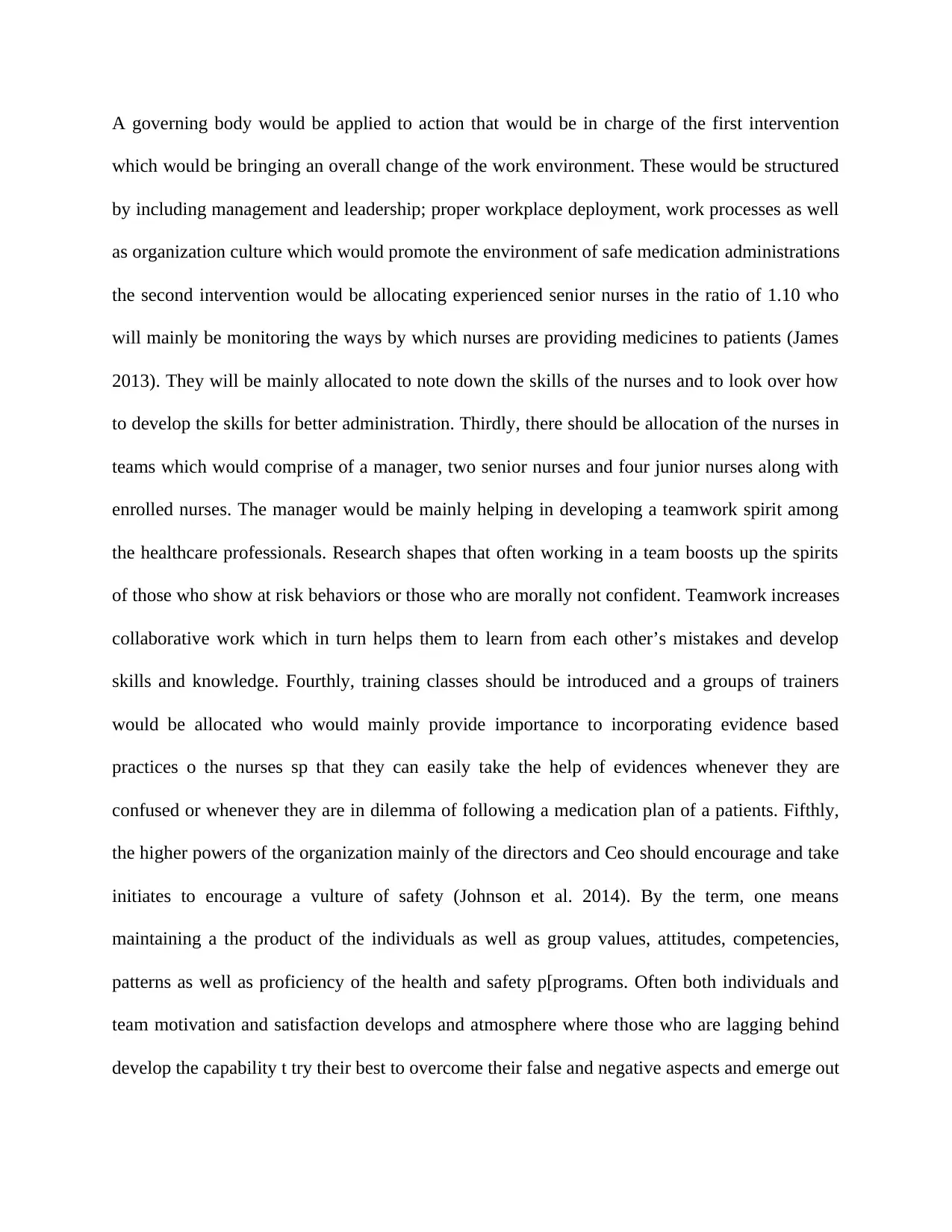
A governing body would be applied to action that would be in charge of the first intervention
which would be bringing an overall change of the work environment. These would be structured
by including management and leadership; proper workplace deployment, work processes as well
as organization culture which would promote the environment of safe medication administrations
the second intervention would be allocating experienced senior nurses in the ratio of 1.10 who
will mainly be monitoring the ways by which nurses are providing medicines to patients (James
2013). They will be mainly allocated to note down the skills of the nurses and to look over how
to develop the skills for better administration. Thirdly, there should be allocation of the nurses in
teams which would comprise of a manager, two senior nurses and four junior nurses along with
enrolled nurses. The manager would be mainly helping in developing a teamwork spirit among
the healthcare professionals. Research shapes that often working in a team boosts up the spirits
of those who show at risk behaviors or those who are morally not confident. Teamwork increases
collaborative work which in turn helps them to learn from each other’s mistakes and develop
skills and knowledge. Fourthly, training classes should be introduced and a groups of trainers
would be allocated who would mainly provide importance to incorporating evidence based
practices o the nurses sp that they can easily take the help of evidences whenever they are
confused or whenever they are in dilemma of following a medication plan of a patients. Fifthly,
the higher powers of the organization mainly of the directors and Ceo should encourage and take
initiates to encourage a vulture of safety (Johnson et al. 2014). By the term, one means
maintaining a the product of the individuals as well as group values, attitudes, competencies,
patterns as well as proficiency of the health and safety p[programs. Often both individuals and
team motivation and satisfaction develops and atmosphere where those who are lagging behind
develop the capability t try their best to overcome their false and negative aspects and emerge out
which would be bringing an overall change of the work environment. These would be structured
by including management and leadership; proper workplace deployment, work processes as well
as organization culture which would promote the environment of safe medication administrations
the second intervention would be allocating experienced senior nurses in the ratio of 1.10 who
will mainly be monitoring the ways by which nurses are providing medicines to patients (James
2013). They will be mainly allocated to note down the skills of the nurses and to look over how
to develop the skills for better administration. Thirdly, there should be allocation of the nurses in
teams which would comprise of a manager, two senior nurses and four junior nurses along with
enrolled nurses. The manager would be mainly helping in developing a teamwork spirit among
the healthcare professionals. Research shapes that often working in a team boosts up the spirits
of those who show at risk behaviors or those who are morally not confident. Teamwork increases
collaborative work which in turn helps them to learn from each other’s mistakes and develop
skills and knowledge. Fourthly, training classes should be introduced and a groups of trainers
would be allocated who would mainly provide importance to incorporating evidence based
practices o the nurses sp that they can easily take the help of evidences whenever they are
confused or whenever they are in dilemma of following a medication plan of a patients. Fifthly,
the higher powers of the organization mainly of the directors and Ceo should encourage and take
initiates to encourage a vulture of safety (Johnson et al. 2014). By the term, one means
maintaining a the product of the individuals as well as group values, attitudes, competencies,
patterns as well as proficiency of the health and safety p[programs. Often both individuals and
team motivation and satisfaction develops and atmosphere where those who are lagging behind
develop the capability t try their best to overcome their false and negative aspects and emerge out
Paraphrase This Document
Need a fresh take? Get an instant paraphrase of this document with our AI Paraphraser
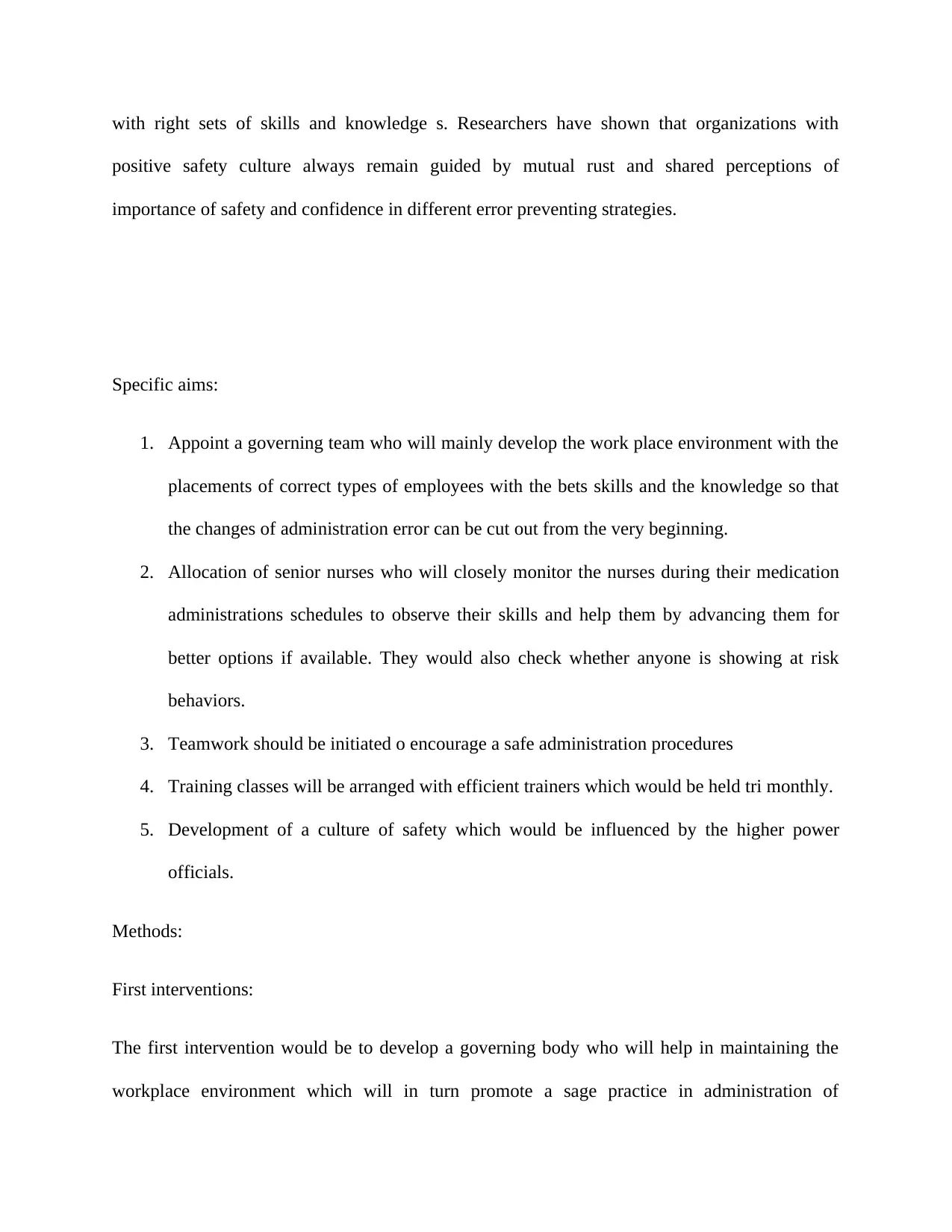
with right sets of skills and knowledge s. Researchers have shown that organizations with
positive safety culture always remain guided by mutual rust and shared perceptions of
importance of safety and confidence in different error preventing strategies.
Specific aims:
1. Appoint a governing team who will mainly develop the work place environment with the
placements of correct types of employees with the bets skills and the knowledge so that
the changes of administration error can be cut out from the very beginning.
2. Allocation of senior nurses who will closely monitor the nurses during their medication
administrations schedules to observe their skills and help them by advancing them for
better options if available. They would also check whether anyone is showing at risk
behaviors.
3. Teamwork should be initiated o encourage a safe administration procedures
4. Training classes will be arranged with efficient trainers which would be held tri monthly.
5. Development of a culture of safety which would be influenced by the higher power
officials.
Methods:
First interventions:
The first intervention would be to develop a governing body who will help in maintaining the
workplace environment which will in turn promote a sage practice in administration of
positive safety culture always remain guided by mutual rust and shared perceptions of
importance of safety and confidence in different error preventing strategies.
Specific aims:
1. Appoint a governing team who will mainly develop the work place environment with the
placements of correct types of employees with the bets skills and the knowledge so that
the changes of administration error can be cut out from the very beginning.
2. Allocation of senior nurses who will closely monitor the nurses during their medication
administrations schedules to observe their skills and help them by advancing them for
better options if available. They would also check whether anyone is showing at risk
behaviors.
3. Teamwork should be initiated o encourage a safe administration procedures
4. Training classes will be arranged with efficient trainers which would be held tri monthly.
5. Development of a culture of safety which would be influenced by the higher power
officials.
Methods:
First interventions:
The first intervention would be to develop a governing body who will help in maintaining the
workplace environment which will in turn promote a sage practice in administration of
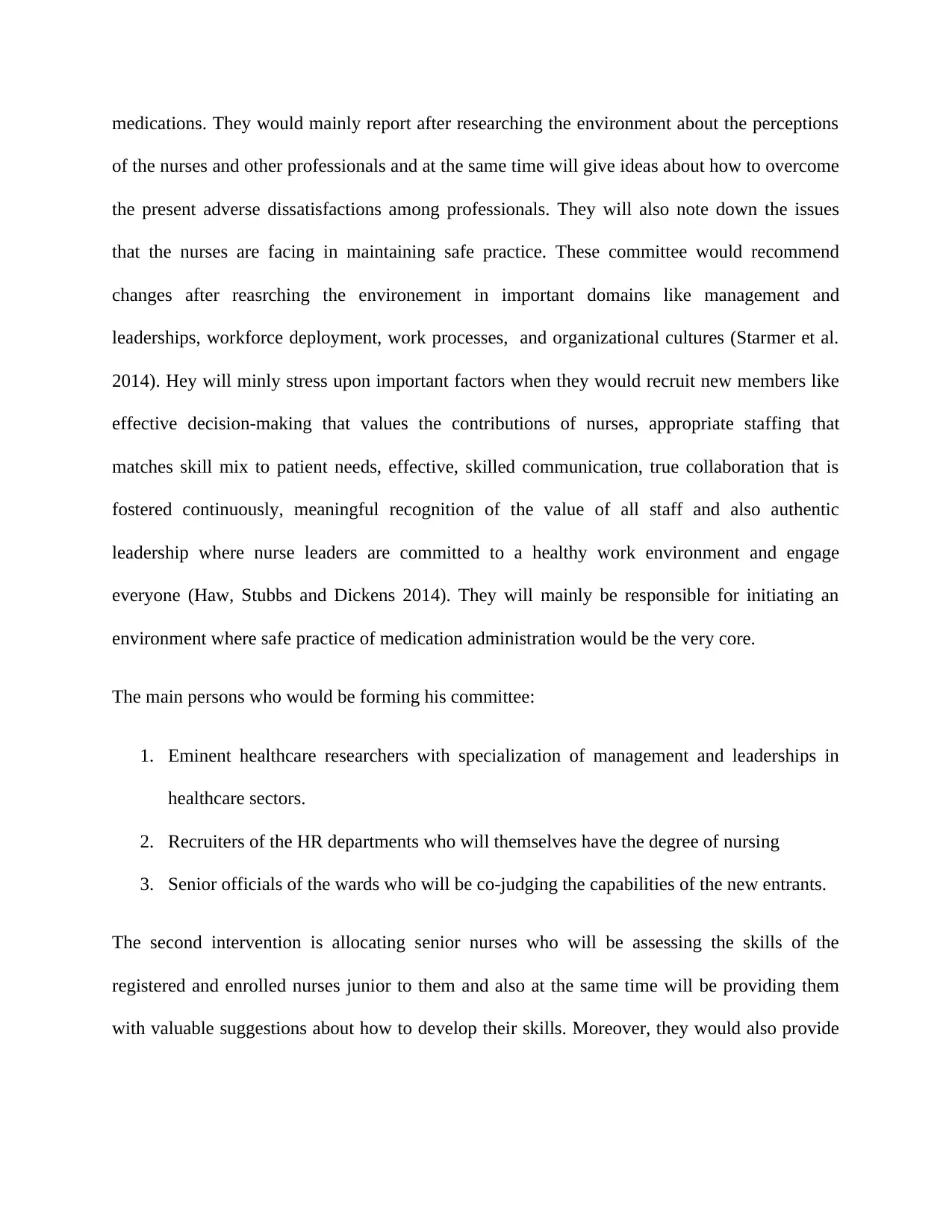
medications. They would mainly report after researching the environment about the perceptions
of the nurses and other professionals and at the same time will give ideas about how to overcome
the present adverse dissatisfactions among professionals. They will also note down the issues
that the nurses are facing in maintaining safe practice. These committee would recommend
changes after reasrching the environement in important domains like management and
leaderships, workforce deployment, work processes, and organizational cultures (Starmer et al.
2014). Hey will minly stress upon important factors when they would recruit new members like
effective decision-making that values the contributions of nurses, appropriate staffing that
matches skill mix to patient needs, effective, skilled communication, true collaboration that is
fostered continuously, meaningful recognition of the value of all staff and also authentic
leadership where nurse leaders are committed to a healthy work environment and engage
everyone (Haw, Stubbs and Dickens 2014). They will mainly be responsible for initiating an
environment where safe practice of medication administration would be the very core.
The main persons who would be forming his committee:
1. Eminent healthcare researchers with specialization of management and leaderships in
healthcare sectors.
2. Recruiters of the HR departments who will themselves have the degree of nursing
3. Senior officials of the wards who will be co-judging the capabilities of the new entrants.
The second intervention is allocating senior nurses who will be assessing the skills of the
registered and enrolled nurses junior to them and also at the same time will be providing them
with valuable suggestions about how to develop their skills. Moreover, they would also provide
of the nurses and other professionals and at the same time will give ideas about how to overcome
the present adverse dissatisfactions among professionals. They will also note down the issues
that the nurses are facing in maintaining safe practice. These committee would recommend
changes after reasrching the environement in important domains like management and
leaderships, workforce deployment, work processes, and organizational cultures (Starmer et al.
2014). Hey will minly stress upon important factors when they would recruit new members like
effective decision-making that values the contributions of nurses, appropriate staffing that
matches skill mix to patient needs, effective, skilled communication, true collaboration that is
fostered continuously, meaningful recognition of the value of all staff and also authentic
leadership where nurse leaders are committed to a healthy work environment and engage
everyone (Haw, Stubbs and Dickens 2014). They will mainly be responsible for initiating an
environment where safe practice of medication administration would be the very core.
The main persons who would be forming his committee:
1. Eminent healthcare researchers with specialization of management and leaderships in
healthcare sectors.
2. Recruiters of the HR departments who will themselves have the degree of nursing
3. Senior officials of the wards who will be co-judging the capabilities of the new entrants.
The second intervention is allocating senior nurses who will be assessing the skills of the
registered and enrolled nurses junior to them and also at the same time will be providing them
with valuable suggestions about how to develop their skills. Moreover, they would also provide
⊘ This is a preview!⊘
Do you want full access?
Subscribe today to unlock all pages.

Trusted by 1+ million students worldwide
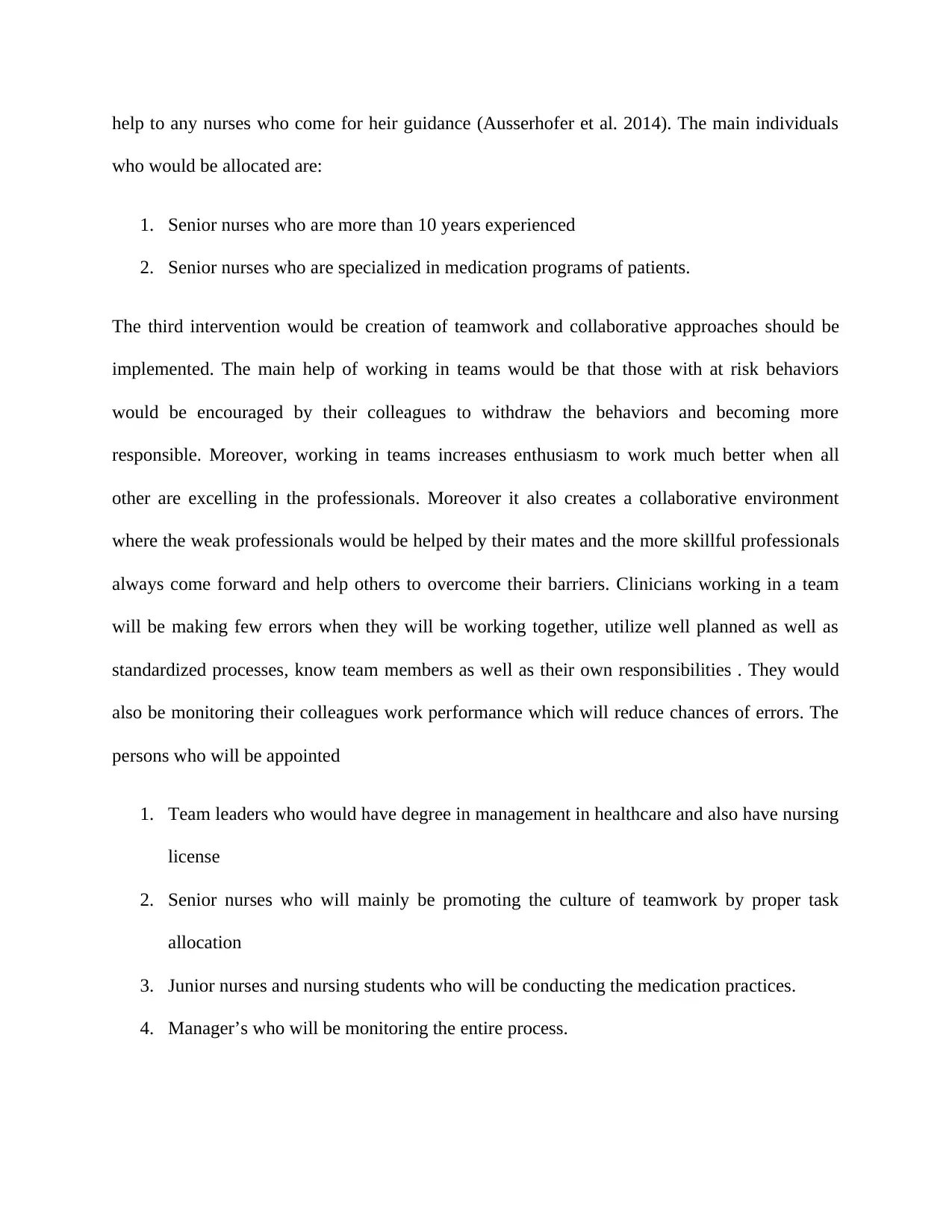
help to any nurses who come for heir guidance (Ausserhofer et al. 2014). The main individuals
who would be allocated are:
1. Senior nurses who are more than 10 years experienced
2. Senior nurses who are specialized in medication programs of patients.
The third intervention would be creation of teamwork and collaborative approaches should be
implemented. The main help of working in teams would be that those with at risk behaviors
would be encouraged by their colleagues to withdraw the behaviors and becoming more
responsible. Moreover, working in teams increases enthusiasm to work much better when all
other are excelling in the professionals. Moreover it also creates a collaborative environment
where the weak professionals would be helped by their mates and the more skillful professionals
always come forward and help others to overcome their barriers. Clinicians working in a team
will be making few errors when they will be working together, utilize well planned as well as
standardized processes, know team members as well as their own responsibilities . They would
also be monitoring their colleagues work performance which will reduce chances of errors. The
persons who will be appointed
1. Team leaders who would have degree in management in healthcare and also have nursing
license
2. Senior nurses who will mainly be promoting the culture of teamwork by proper task
allocation
3. Junior nurses and nursing students who will be conducting the medication practices.
4. Manager’s who will be monitoring the entire process.
who would be allocated are:
1. Senior nurses who are more than 10 years experienced
2. Senior nurses who are specialized in medication programs of patients.
The third intervention would be creation of teamwork and collaborative approaches should be
implemented. The main help of working in teams would be that those with at risk behaviors
would be encouraged by their colleagues to withdraw the behaviors and becoming more
responsible. Moreover, working in teams increases enthusiasm to work much better when all
other are excelling in the professionals. Moreover it also creates a collaborative environment
where the weak professionals would be helped by their mates and the more skillful professionals
always come forward and help others to overcome their barriers. Clinicians working in a team
will be making few errors when they will be working together, utilize well planned as well as
standardized processes, know team members as well as their own responsibilities . They would
also be monitoring their colleagues work performance which will reduce chances of errors. The
persons who will be appointed
1. Team leaders who would have degree in management in healthcare and also have nursing
license
2. Senior nurses who will mainly be promoting the culture of teamwork by proper task
allocation
3. Junior nurses and nursing students who will be conducting the medication practices.
4. Manager’s who will be monitoring the entire process.
Paraphrase This Document
Need a fresh take? Get an instant paraphrase of this document with our AI Paraphraser
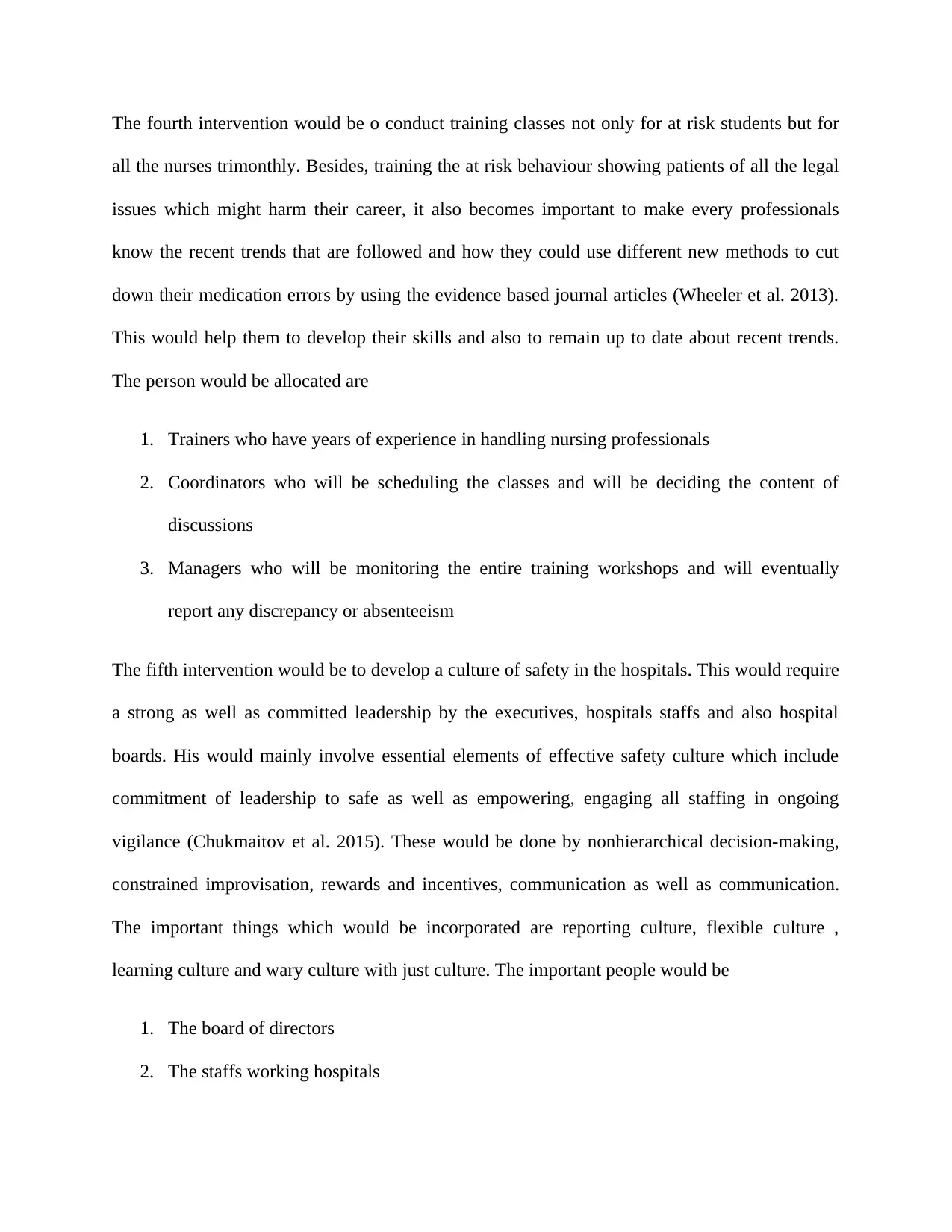
The fourth intervention would be o conduct training classes not only for at risk students but for
all the nurses trimonthly. Besides, training the at risk behaviour showing patients of all the legal
issues which might harm their career, it also becomes important to make every professionals
know the recent trends that are followed and how they could use different new methods to cut
down their medication errors by using the evidence based journal articles (Wheeler et al. 2013).
This would help them to develop their skills and also to remain up to date about recent trends.
The person would be allocated are
1. Trainers who have years of experience in handling nursing professionals
2. Coordinators who will be scheduling the classes and will be deciding the content of
discussions
3. Managers who will be monitoring the entire training workshops and will eventually
report any discrepancy or absenteeism
The fifth intervention would be to develop a culture of safety in the hospitals. This would require
a strong as well as committed leadership by the executives, hospitals staffs and also hospital
boards. His would mainly involve essential elements of effective safety culture which include
commitment of leadership to safe as well as empowering, engaging all staffing in ongoing
vigilance (Chukmaitov et al. 2015). These would be done by nonhierarchical decision-making,
constrained improvisation, rewards and incentives, communication as well as communication.
The important things which would be incorporated are reporting culture, flexible culture ,
learning culture and wary culture with just culture. The important people would be
1. The board of directors
2. The staffs working hospitals
all the nurses trimonthly. Besides, training the at risk behaviour showing patients of all the legal
issues which might harm their career, it also becomes important to make every professionals
know the recent trends that are followed and how they could use different new methods to cut
down their medication errors by using the evidence based journal articles (Wheeler et al. 2013).
This would help them to develop their skills and also to remain up to date about recent trends.
The person would be allocated are
1. Trainers who have years of experience in handling nursing professionals
2. Coordinators who will be scheduling the classes and will be deciding the content of
discussions
3. Managers who will be monitoring the entire training workshops and will eventually
report any discrepancy or absenteeism
The fifth intervention would be to develop a culture of safety in the hospitals. This would require
a strong as well as committed leadership by the executives, hospitals staffs and also hospital
boards. His would mainly involve essential elements of effective safety culture which include
commitment of leadership to safe as well as empowering, engaging all staffing in ongoing
vigilance (Chukmaitov et al. 2015). These would be done by nonhierarchical decision-making,
constrained improvisation, rewards and incentives, communication as well as communication.
The important things which would be incorporated are reporting culture, flexible culture ,
learning culture and wary culture with just culture. The important people would be
1. The board of directors
2. The staffs working hospitals
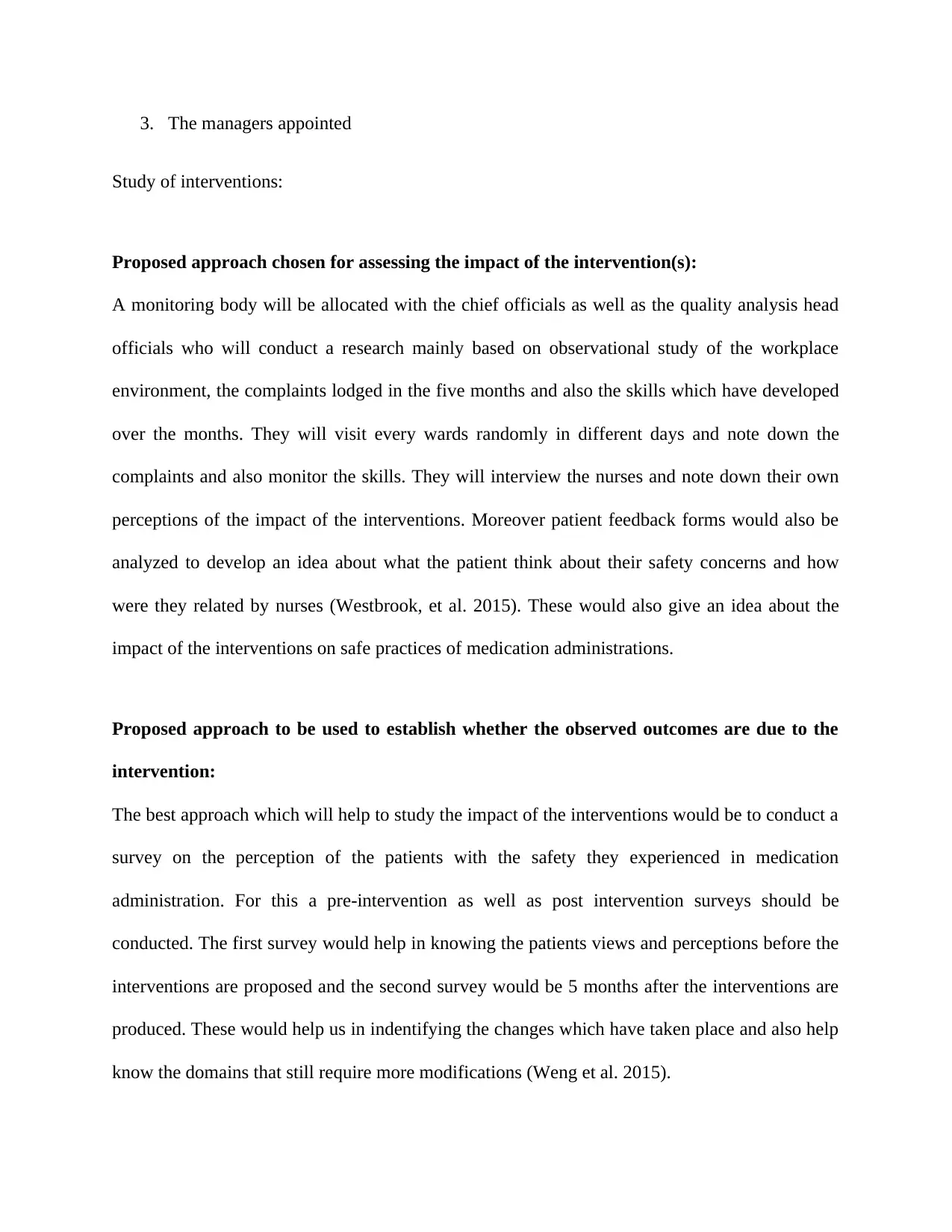
3. The managers appointed
Study of interventions:
Proposed approach chosen for assessing the impact of the intervention(s):
A monitoring body will be allocated with the chief officials as well as the quality analysis head
officials who will conduct a research mainly based on observational study of the workplace
environment, the complaints lodged in the five months and also the skills which have developed
over the months. They will visit every wards randomly in different days and note down the
complaints and also monitor the skills. They will interview the nurses and note down their own
perceptions of the impact of the interventions. Moreover patient feedback forms would also be
analyzed to develop an idea about what the patient think about their safety concerns and how
were they related by nurses (Westbrook, et al. 2015). These would also give an idea about the
impact of the interventions on safe practices of medication administrations.
Proposed approach to be used to establish whether the observed outcomes are due to the
intervention:
The best approach which will help to study the impact of the interventions would be to conduct a
survey on the perception of the patients with the safety they experienced in medication
administration. For this a pre-intervention as well as post intervention surveys should be
conducted. The first survey would help in knowing the patients views and perceptions before the
interventions are proposed and the second survey would be 5 months after the interventions are
produced. These would help us in indentifying the changes which have taken place and also help
know the domains that still require more modifications (Weng et al. 2015).
Study of interventions:
Proposed approach chosen for assessing the impact of the intervention(s):
A monitoring body will be allocated with the chief officials as well as the quality analysis head
officials who will conduct a research mainly based on observational study of the workplace
environment, the complaints lodged in the five months and also the skills which have developed
over the months. They will visit every wards randomly in different days and note down the
complaints and also monitor the skills. They will interview the nurses and note down their own
perceptions of the impact of the interventions. Moreover patient feedback forms would also be
analyzed to develop an idea about what the patient think about their safety concerns and how
were they related by nurses (Westbrook, et al. 2015). These would also give an idea about the
impact of the interventions on safe practices of medication administrations.
Proposed approach to be used to establish whether the observed outcomes are due to the
intervention:
The best approach which will help to study the impact of the interventions would be to conduct a
survey on the perception of the patients with the safety they experienced in medication
administration. For this a pre-intervention as well as post intervention surveys should be
conducted. The first survey would help in knowing the patients views and perceptions before the
interventions are proposed and the second survey would be 5 months after the interventions are
produced. These would help us in indentifying the changes which have taken place and also help
know the domains that still require more modifications (Weng et al. 2015).
⊘ This is a preview!⊘
Do you want full access?
Subscribe today to unlock all pages.

Trusted by 1+ million students worldwide
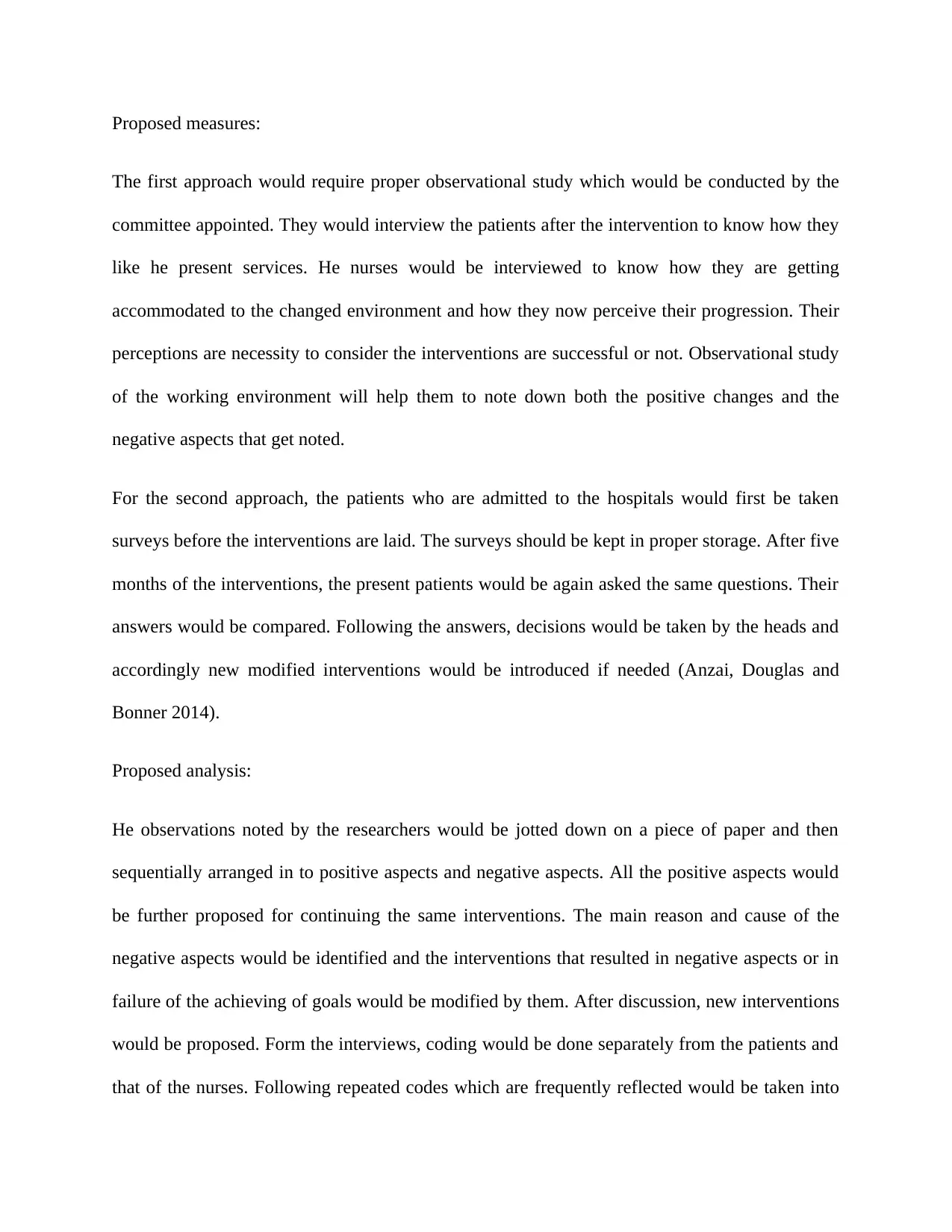
Proposed measures:
The first approach would require proper observational study which would be conducted by the
committee appointed. They would interview the patients after the intervention to know how they
like he present services. He nurses would be interviewed to know how they are getting
accommodated to the changed environment and how they now perceive their progression. Their
perceptions are necessity to consider the interventions are successful or not. Observational study
of the working environment will help them to note down both the positive changes and the
negative aspects that get noted.
For the second approach, the patients who are admitted to the hospitals would first be taken
surveys before the interventions are laid. The surveys should be kept in proper storage. After five
months of the interventions, the present patients would be again asked the same questions. Their
answers would be compared. Following the answers, decisions would be taken by the heads and
accordingly new modified interventions would be introduced if needed (Anzai, Douglas and
Bonner 2014).
Proposed analysis:
He observations noted by the researchers would be jotted down on a piece of paper and then
sequentially arranged in to positive aspects and negative aspects. All the positive aspects would
be further proposed for continuing the same interventions. The main reason and cause of the
negative aspects would be identified and the interventions that resulted in negative aspects or in
failure of the achieving of goals would be modified by them. After discussion, new interventions
would be proposed. Form the interviews, coding would be done separately from the patients and
that of the nurses. Following repeated codes which are frequently reflected would be taken into
The first approach would require proper observational study which would be conducted by the
committee appointed. They would interview the patients after the intervention to know how they
like he present services. He nurses would be interviewed to know how they are getting
accommodated to the changed environment and how they now perceive their progression. Their
perceptions are necessity to consider the interventions are successful or not. Observational study
of the working environment will help them to note down both the positive changes and the
negative aspects that get noted.
For the second approach, the patients who are admitted to the hospitals would first be taken
surveys before the interventions are laid. The surveys should be kept in proper storage. After five
months of the interventions, the present patients would be again asked the same questions. Their
answers would be compared. Following the answers, decisions would be taken by the heads and
accordingly new modified interventions would be introduced if needed (Anzai, Douglas and
Bonner 2014).
Proposed analysis:
He observations noted by the researchers would be jotted down on a piece of paper and then
sequentially arranged in to positive aspects and negative aspects. All the positive aspects would
be further proposed for continuing the same interventions. The main reason and cause of the
negative aspects would be identified and the interventions that resulted in negative aspects or in
failure of the achieving of goals would be modified by them. After discussion, new interventions
would be proposed. Form the interviews, coding would be done separately from the patients and
that of the nurses. Following repeated codes which are frequently reflected would be taken into
Paraphrase This Document
Need a fresh take? Get an instant paraphrase of this document with our AI Paraphraser
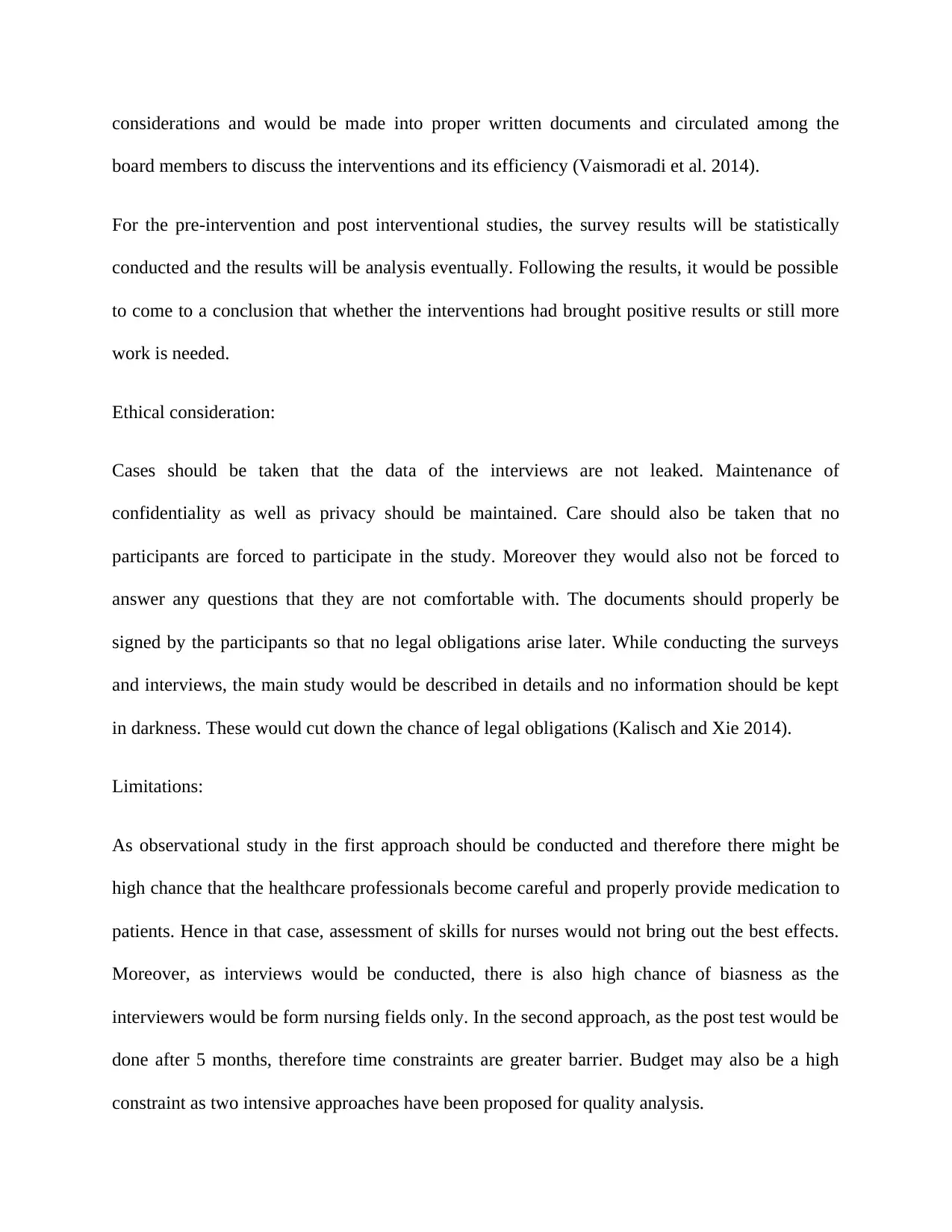
considerations and would be made into proper written documents and circulated among the
board members to discuss the interventions and its efficiency (Vaismoradi et al. 2014).
For the pre-intervention and post interventional studies, the survey results will be statistically
conducted and the results will be analysis eventually. Following the results, it would be possible
to come to a conclusion that whether the interventions had brought positive results or still more
work is needed.
Ethical consideration:
Cases should be taken that the data of the interviews are not leaked. Maintenance of
confidentiality as well as privacy should be maintained. Care should also be taken that no
participants are forced to participate in the study. Moreover they would also not be forced to
answer any questions that they are not comfortable with. The documents should properly be
signed by the participants so that no legal obligations arise later. While conducting the surveys
and interviews, the main study would be described in details and no information should be kept
in darkness. These would cut down the chance of legal obligations (Kalisch and Xie 2014).
Limitations:
As observational study in the first approach should be conducted and therefore there might be
high chance that the healthcare professionals become careful and properly provide medication to
patients. Hence in that case, assessment of skills for nurses would not bring out the best effects.
Moreover, as interviews would be conducted, there is also high chance of biasness as the
interviewers would be form nursing fields only. In the second approach, as the post test would be
done after 5 months, therefore time constraints are greater barrier. Budget may also be a high
constraint as two intensive approaches have been proposed for quality analysis.
board members to discuss the interventions and its efficiency (Vaismoradi et al. 2014).
For the pre-intervention and post interventional studies, the survey results will be statistically
conducted and the results will be analysis eventually. Following the results, it would be possible
to come to a conclusion that whether the interventions had brought positive results or still more
work is needed.
Ethical consideration:
Cases should be taken that the data of the interviews are not leaked. Maintenance of
confidentiality as well as privacy should be maintained. Care should also be taken that no
participants are forced to participate in the study. Moreover they would also not be forced to
answer any questions that they are not comfortable with. The documents should properly be
signed by the participants so that no legal obligations arise later. While conducting the surveys
and interviews, the main study would be described in details and no information should be kept
in darkness. These would cut down the chance of legal obligations (Kalisch and Xie 2014).
Limitations:
As observational study in the first approach should be conducted and therefore there might be
high chance that the healthcare professionals become careful and properly provide medication to
patients. Hence in that case, assessment of skills for nurses would not bring out the best effects.
Moreover, as interviews would be conducted, there is also high chance of biasness as the
interviewers would be form nursing fields only. In the second approach, as the post test would be
done after 5 months, therefore time constraints are greater barrier. Budget may also be a high
constraint as two intensive approaches have been proposed for quality analysis.
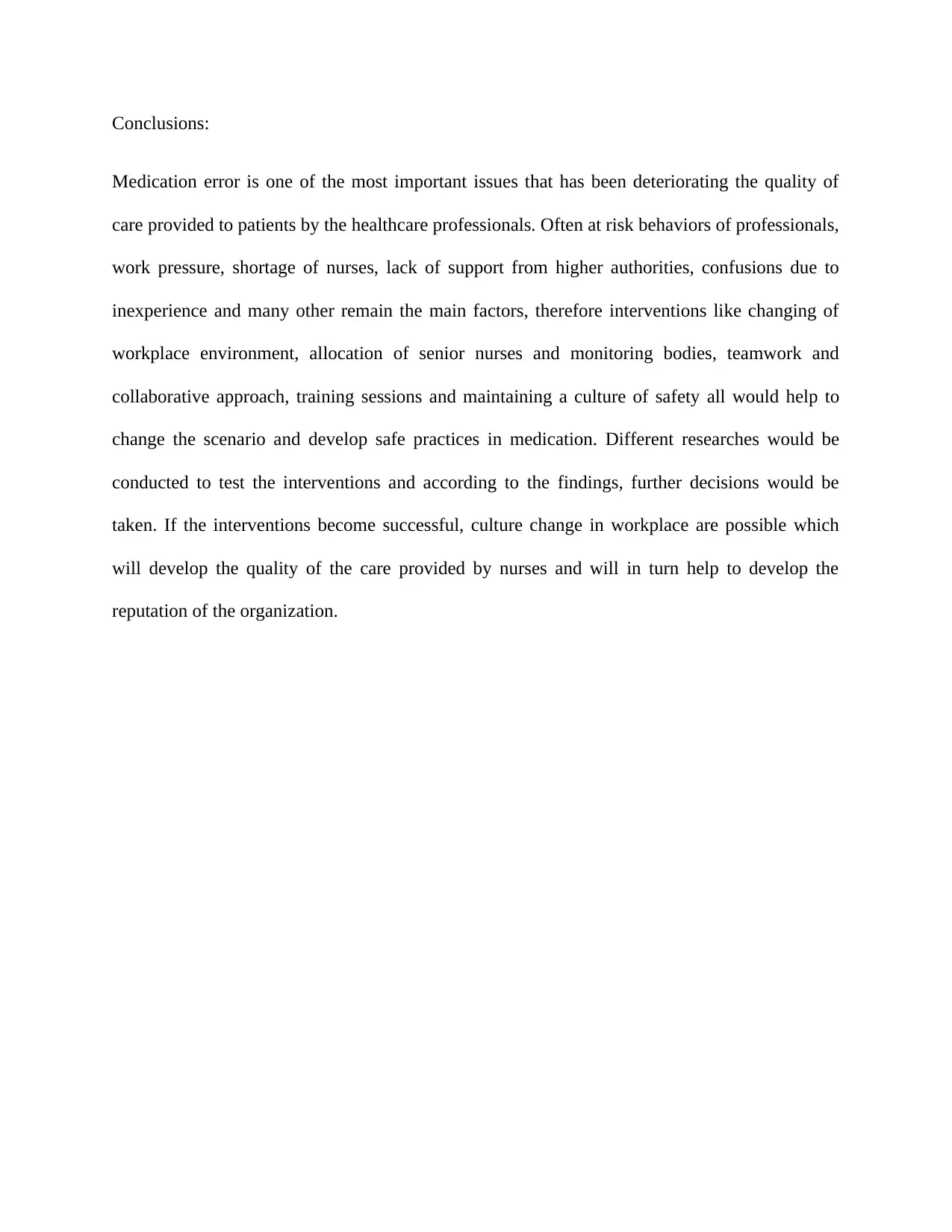
Conclusions:
Medication error is one of the most important issues that has been deteriorating the quality of
care provided to patients by the healthcare professionals. Often at risk behaviors of professionals,
work pressure, shortage of nurses, lack of support from higher authorities, confusions due to
inexperience and many other remain the main factors, therefore interventions like changing of
workplace environment, allocation of senior nurses and monitoring bodies, teamwork and
collaborative approach, training sessions and maintaining a culture of safety all would help to
change the scenario and develop safe practices in medication. Different researches would be
conducted to test the interventions and according to the findings, further decisions would be
taken. If the interventions become successful, culture change in workplace are possible which
will develop the quality of the care provided by nurses and will in turn help to develop the
reputation of the organization.
Medication error is one of the most important issues that has been deteriorating the quality of
care provided to patients by the healthcare professionals. Often at risk behaviors of professionals,
work pressure, shortage of nurses, lack of support from higher authorities, confusions due to
inexperience and many other remain the main factors, therefore interventions like changing of
workplace environment, allocation of senior nurses and monitoring bodies, teamwork and
collaborative approach, training sessions and maintaining a culture of safety all would help to
change the scenario and develop safe practices in medication. Different researches would be
conducted to test the interventions and according to the findings, further decisions would be
taken. If the interventions become successful, culture change in workplace are possible which
will develop the quality of the care provided by nurses and will in turn help to develop the
reputation of the organization.
⊘ This is a preview!⊘
Do you want full access?
Subscribe today to unlock all pages.

Trusted by 1+ million students worldwide
1 out of 18
Related Documents
Your All-in-One AI-Powered Toolkit for Academic Success.
+13062052269
info@desklib.com
Available 24*7 on WhatsApp / Email
![[object Object]](/_next/static/media/star-bottom.7253800d.svg)
Unlock your academic potential
Copyright © 2020–2025 A2Z Services. All Rights Reserved. Developed and managed by ZUCOL.





